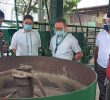By IBON Media
MANILA, Philippines – The global economic situation is expected to continue deteriorating until 2010 and even beyond, and the Philippines is going to be severely affected by the worsening crisis. Yet it is still possible to mitigate the effects on the country, and more importantly, to emerge from this period of crisis with a genuinely strengthening and forward-moving economy.
Various factors will come into fuller play by next year and action must be taken as soon as possible. The economy has been deteriorating steadily in recent years despite government hype and, as it is, growth has been slowing since the start of the year. The onset of global financial and economic turmoil however now pushes it into a deeper crisis that it is poorly equipped to deal with.
Economic distress
The slowdown that begun in 2008 and will carry through until next year is clear. Growth this year and next year could easily turn out the slowest in a decade. Joblessness will increase and add to the 4.1 million unemployed � estimated to include the jobless statistically removed from the labor force to lower officially reported figures � and 6.8 million underemployed as of 2007. The number of jobless and underemployed next year will very likely rise to well over eleven to twelve million.
Retrenchments and closures will be most immediately felt in the goods and services export sectors. Particularly affected will be the major sub sectors of electronics (sixty-seven percent of exports in 2007), apparel and clothing (five percent), and furniture and woodcrafts (two percent). The US in particular is the largest buyer of Philippine garments and furniture and receives eighty percent of total garments exports and sixty percent of total furniture exports. The crisis will weaken global demand for laptops, cameras and cellular phones which are the primary users of the semi-conductors and microprocessors that the country exports. As it is, the country�s export-oriented electronics sub sector employs some 500,000-600,000 workers. The US is also the world�s largest end-consumer of electronics.
The business process outsourcing (BPO) industry will also likely be badly affected with the US accounting for over two-thirds of foreign equity and ninety percent of BPO export revenue. The grand target of 940,000 BPO jobs by 2010 is even more impossible especially with employment at most at just 320,000 now. Similarly with local tourism and business travel outfits where hotels and restaurants will feel the pinch of less foreign and domestic visitors.
The jobs situation has clearly started to worsen in 2008. The number of jobless Filipinos drastically increased by 279,000 in October from the same period last year and increased the unemployment rate by 0.6 percentage points. Rough approximations correcting for the government’s recent maneuver of underestimating unemployment place the number of jobless Filipinos at around 4.3 million and the unemployment rate at over eleven percent.
The important manufacturing sector lost another 159,000 jobs from the year before, the transport, storage and communication sector lost 10,000 jobs, and financial intermediation lost 4,000 jobs. These trends are likely to continue until next year and be aggravated by deteriorating jobs in construction, finance and wholesale and retail trade. Small and medium enterprises in particular will have a harder time borrowing with creditors preferring perceived “safer” large borrowers.
Filipinos working overseas in distressed countries and sectors face layoffs or at least lower incomes. This is not just in the US where the crisis first erupted but also wherever in the world they might be and no country is untouched by the tumult. The US is notable though in that over half of all remittances� reaching fifty or US$7.6 B of US$14.5 B in 2007� come from the US or via US-based banks.
Overseas Filipinos will do their best and be making even greater sacrifices to maintain remittances to their families in the country. But remittance flows are still certain to weaken in 2009 and perhaps even significantly. At the very least there will be a slowdown in deployments to the US, Europe, Middle East, East Asia and seaborne work where the overwhelming number of overseas Filipinos go and a corresponding drop in growth of remittances from abroad. The corresponding drop in household incomes will have repercussions on domestic sales of consumer goods and services and even of residential real estate.
The job losses and squeeze on wages, benefits and remittances will combine with rising prices and have an immediate impact on household incomes that will cause poverty to rise. But the spending will also have further depressing effects � possibly beginning with domestic wholesale, retailing and food services as stores and restaurants face lower consumer spending. Additional pressure comes from the generalized slowdown due to overall economic uncertainty, lower consumption, tighter credit and depressed investments. The poorer business sentiment and tightening of capital flows is already reflected in steep stock market drops and much higher interest rates.
External financing for the country is dropping steeply. The US$912 million net outflow of foreign portfolio investments in the January-October 2008 period is a drastic reversal from the US$3.7 billion inflow in the same period last year. Net FDI is going in the same direction and fell by more than half to US$1.1 billion in January-August 2008 from US$2.5 billion in the same period in 2007. There is also a strong possibility that the rate at which official development assistance (Oda) is declining will worsen in the coming years as donor governments prioritize domestic financing needs. As it is Oda has already fallen thirty percent to US$9.2 billion last year from US$13.2 billion in 2001.
Immediate relief and strengthening the economy
There are two stages in coping with the crisis. The first stage is to arrest the slowdown in economic activity and the corresponding worsening in unemployment, incomes and poverty. This is critical especially since the country has already been suffering record unemployment, falling incomes and rising poverty in the last few years.
The effects of the economic downturn must be countered by stimulating the economy through expansionary and, importantly, equity-building policies. This includes:
1. Providing immediate emergency food, income and work relief.
2. Increasing public spending on health care, basic education and housing for the people and restoring real per capita social services spending to at least 1997 levels.
3. Increasing public spending on labor-intensive and rural infrastructure projects that will directly improve people’s livelihoods.
4. Public resources can be freed by:
5. Giving priority to Filipino producers in government procurement and aid-funded projects.
6. Implementing a P125 across the board nationwide wage hike and a three thousand peso- increase in government salaries.
7. Removing the Vat on oil products and increasing taxation of wealth, luxury goods and services, and on unproductive assets and transactions.
8. Reducing interest rates while ensuring that credit remains available.
There is also a need to immediately stabilize capital flows with capital controls, especially against outflows right now, and supporting the exchange rate. Capital controls must be used to defend against speculative attacks or financial transactions not related to trade and production.
The advanced capitalist countries are pushed to become all the more aggressive in pushing to open up neo-colonial countries as vents for their crisis. There are two particular areas of concern. The first is how the International Monetary Fund (IMF), World Bank and other creditors will exploit the situation to leverage further policy conditionalities through their loans and aid. The second is how free trade agreements (FTAs) will be packaged as solutions for slowing domestic economies. This includes not just FTAs between vastly unequal parties but also those packaged as intra-Third World deals that merely create regional production lines for the benefit of the big powers. All maneuvering such as these must be vigorously opposed.
The second stage involves laying the foundations for economic development and reducing internal and external vulnerabilities to inevitable crises. Unsound fundamentals do not just make short-term prospects poor but also make long-term development prospects bleak. The welfare of tens of millions of Filipinos will not improve given current trends of deteriorating manufacturing, backward agriculture, poor savings and investment rates (i.e., capital accumulation), failing social services, falling incomes and rising poverty. In terms of the overall economy it is particularly critical to genuinely strengthen domestic agriculture and industry.
The economy’s problems are far beyond piecemeal solutions. A radical change in socioeconomic policies is needed if there is going to be any hope of lifting the tens of millions of poor Filipinos out of their deprivation. This much is clear from the Philippine’s poor development experience and chronic poverty over the last six decades: the stubbornly elite-biased and increasingly “free market”-oriented policies are a development dead-end. Alternative socioeconomic policies must be geared towards what is strategically necessary to improve the economy and people’s welfare. In the concrete economic and political conditions of Philippine society today this can only mean genuine agrarian reform and national industrialization. (IBON Features)
Analysis, crisis in 2009









